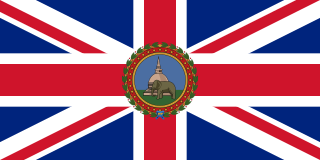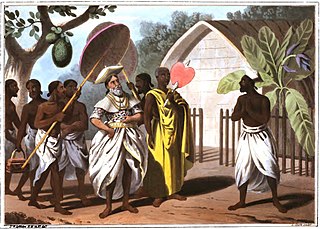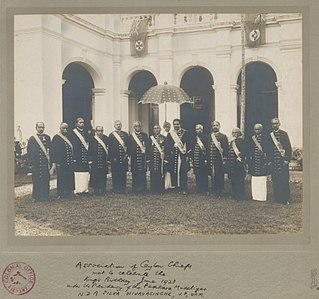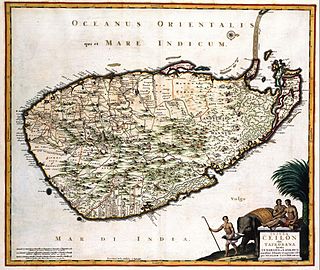
Rate Mahatmaya was a traditional office and title from the Kandian Kingdom which became part of the British colonial administration within the Kandian and central region of Ceylon. [1]

Rate Mahatmaya was a traditional office and title from the Kandian Kingdom which became part of the British colonial administration within the Kandian and central region of Ceylon. [1]
Persons were appointed to the title and office by the King during the Kingdom of Kandy, these appointees headed the administration of a large locality known as Korale, which was a division of the province of the Kingdom known as a Dissava and as such he would be subordinate to the local Dissava. There was no time limit for the officer holder as he held the post at the pleasure of the King, which meant throughout his life, if not incurred the displeasure of the King. It was not hereditary, although members of the same family have been appointed. They were members of the Radala Cast, who were referred to as the Chieftains of Kandy by the British. Many were instrumental in the surrender of the Kandian Kingdom to the British.
Following the expansion of British rule into the provinces of the former Kandian Kingdom in 1815, the British retained the office of Rate Mahatmaya appointing Kandians loyal to the British Crown. Following the Uva Rebellion in 1818 and changers to the administrative divisions of the island with the creation of Districts, British Government Agents (GA) took over the duties of the Dissava, with Rate Mahatmaya becoming a subordinate to the local Government Agents and Assistant Government Agents. During the British administration a Rate Mahatmaya would head a revenue district, a Korale and would e the Kandian equivalent to a Mudaliyar in the lower country or the coastal regions. New appointments were stopped in the 1931 after the abolition of the native department, while current holders retained their posts until their retirement while transferable District Revenue Officers were appointed as replacements. The last Rate Mahatmaya to retire was in the late 1950s. [1]

The Kandyan Wars refers generally to the period of warfare between the British colonial forces and the Kingdom of Kandy, on the island of what is now Sri Lanka, between 1796 and 1818. More specifically it is used to describe the expeditionary campaigns of the British Army in the Kingdom of Kandy in 1803 and 1815.

The governor of Ceylon was the representative in Ceylon of the British Crown from 1795 to 1948. In this capacity, the governor was president of the Executive Council and Commander-in-Chief of the British Forces in Ceylon. The governor was the head of the British colonial administration in Ceylon, reporting to the Colonial Office.

Radala refers to a small minority group in Sri Lanka in the former provinces of the Kingdom of Kandy, who are either descendants of chiefs and courtiers of the King of Kandy of Nayaks of Kandy or descendants of native headmen appointed by the British colonial administration following the Uva Rebellion in 1818.

Mudaliyar was a Ceylonese colonial title during Portuguese and British rule of the island. Stemming from the native headman system, the title was usually hereditary, made to wealthy influential families loyal to the British Crown.
A Government Agent (GA) or a District Secretary is a Sri Lankan civil servant of the Sri Lanka Administrative Service appointed by the central government to govern a certain district of the country. The GA is the administrative head of public services in the District. As Sri Lanka has 25 districts, there are 25 governments agents at any given time.

The Kingdom of Kandy was a monarchy on the island of Sri Lanka, located in the central and eastern portion of the island. It was founded in the late 15th century and endured until the early 19th century.

In the history of Sri Lanka, the Kandyan Convention was a treaty signed on 2 March 1815 between the British governor of Ceylon, Sir Robert Brownrigg, and the chiefs of the Kandyan Kingdom, British Ceylon, for the deposition of King Sri Vikrama Rajasinha and ceding of the kingdom's territory to the British Crown. It was signed in the Magul Maduwa of the Royal Palace of Kandy.

The Mahâ Adigâr was a Great Officer in the Amātya Mandalaya, or Sinhalese Council of State, in the Sinhalese Kingdoms of monarchical Sri Lanka. The office was second in power and dignity to the King. Like many of the existing high offices at the time it had combined legislative and judicial powers and functioned primarily equivalent to that of a prime minister and chief justice, but also had duties in the governance of a province. During the Kandyan period there were two Adigars, who were styled Mahâ Nilames, the Pallegampahê Mahâ Nilamê and the Udagampahê Mahâ Nilamê, the former taking precedence over the latter.

The Mahâ Dissâvas was a Great Officer in the Amātya Mandalaya, or Sinhalese Council of State, in the Sinhalese Kingdoms of monarchical Sri Lanka. Like many of the existing high offices at the time it had combined legislative and judicial powers and functioned primarily equivalent to that of a Provincial governor. The office of Dissava was retained under the successive European colonial powers, namely the Portuguese Empire, the Dutch East India Company and the British Empire. A Dissava was the governor a province known as a Disavanies. With his province, the Dissava held both executive and judicial authority.
Arachchi was an influential post in the Native Headmen System in Ceylon during the colonial era. Appointed by the Government Agent of the Province, the holder had much control over the people of the area and wielded quasi-judicial powers since he was responsible to keep the peace, carry out revenue collection and assist in judicial functions.

Deshamanya Edwin Loku Bandara Hurulle was a Sri Lankan politician. He was the Provincial Governor of the Central Province and North Central Province; Cabinet Minister of Communications in Prime Minister Dudley Senanayake's government; Cabinet Minister of Cultural Affairs under President J. R. Jayewardene's government and Member of Parliament.
Barnes Ratwatte was a Ceylonese colonial-era legislator and a headman. He was a member of the State Council and the Senate of Ceylon. He was appointed to the posts of Rate Mahatmaya of Balangoda and Dissawa by the British. He was the father of Sirimavo Bandaranaike, the first female Prime Minister in the world.

Ehelapola Wijesundara Wickramasinghe Chandrasekara Seneviratna Jayatillake Ekanayaka Amarakone Wahala Panditha Mudiyanse, commonly known as Ehelapola Nilame, was a courtier of the Kingdom of Kandy. He was the Pallegampahe Adigar, and held the honorary title of Maha Nilame from 1811 to 1814 under the reign of Sri Vikrama Rajasinha of Kandy. Ehelapola joined a revolt against King Rajasinha in Sabaragamuva province after he was sent to conquer it, and his entire family was executed. He helped the British launch an invasion against the Kandy Kingdom, overthrow Rajasinha, and subjugate Kandy to the British monarchy under the Kandyan Convention. Various records of Sri Lankan history suggest that he aided the British with the plan to later overthrow them. He was later convicted of treason by the British following the Great Rebellion of 1817–18, and was exiled to Mauritius.
Native headmen system was an integral part of the administration of the island of Ceylon under the successive European colonial powers, namely the Portuguese Empire, the Dutch East India Company and the British Empire. Native headmen or leaders were appointed by the European colonial administrators to function as intermediates between the Europeans and the native populous. During different periods through this system these headmen functioned in military, policing, administrative and ceremonial capacities. They served as translators, revenue collectors and wielded quasi-judicial powers. Much of the system evolved and changed over time until some of the last vestiges of it were removed in the post-independent Ceylon.

Muhandiram was a post in the native headmen system in the lower-country of Ceylon during the colonial era. It was awarded as a title of honor until suspension of Ceylonese honours in 1956.

A Korale or Corale was formerly a revenue district in Ceylon. During the British colonial administration, a low country korale was under the purview of a Mudaliyar while an upcountry korale came under the purview of a post that was itself known as Korale or Korale Mahaththaya. To this day localities retain their old names and most land titles retain reference to the Korale the land is located in.
Wickramasinghe Wijesundara Ekanayake Abeykoon Mudiyanse Ralahamilage Sir James Williams Maduwanwela (1844–1930) was a Ceylonese colonial-era headmen. He was appointed to the post of Dissawa by the British Government of Ceylon.
The Vidane or Vithanai was an influential post in the Native Headman System in Ceylon during the colonial era. Appointed by the Government Aagent of the Province. The holder had much control over the people of the area and wielded quasi-judicial powers since he was responsible to keep the peace, carry out revenue collection and assist in judicial functions.